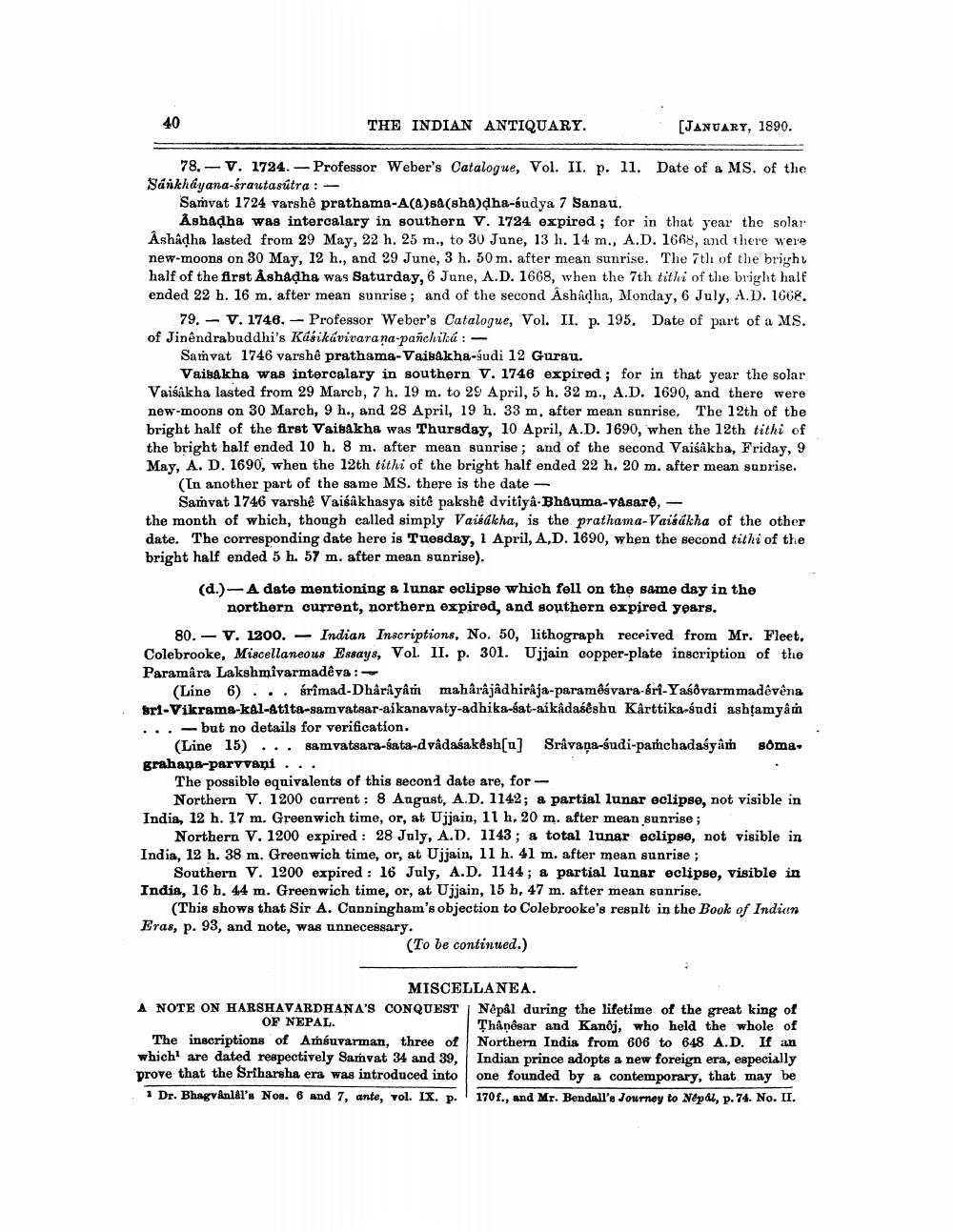________________
40
THE INDIAN ANTIQUARY.
[JANUARY, 1890.
78.-V. 1724.- Professor Weber's Catalogue, Vol. II. p. 11. Date of a MS. of the Sankhayana-srautasútra:
Samvat 1724 varshê prathama-A(a)sa (sha)ḍha-sudya 7 Sanau.
Ashadha was intercalary in southern V. 1724 expired; for in that year the solar Ashadha lasted from 29 May, 22 h. 25 m., to 30 June, 13 h. 14 m., A.D. 1668, and there were new-moons on 30 May, 12 h., and 29 June, 3 h. 50 m. after mean sunrise. The 7th of the bright half of the first Ashadha was Saturday, 6 June, A.D. 1668, when the 7th tithi of the bright half ended 22 h. 16 m. after mean sunrise; and of the second Ashâdha, Monday, 6 July, A.D. 1668.
Date of part of a MS.
79. V. 1746. Professor Weber's Catalogue, Vol. II. p. 195. of Jinêndrabuddhi's Kásikavivaraṇa-pañchiká:
Samvat 1746 varshê prathama-Vaisakha-śudi 12 Gurau.
Vaisakha was intercalary in southern V. 1746 expired; for in that year the solar Vaisakha lasted from 29 March, 7 h. 19 m. to 29 April, 5 h. 32 m., A.D. 1690, and there were new-moons on 30 March, 9 h., and 28 April, 19 h. 33 m. after mean sunrise. The 12th of the bright half of the first Vaisakha was Thursday, 10 April, A.D. 1690, when the 12th tithi of the bright half ended 10 h. 8 m. after mean sunrise; and of the second Vaisâkha, Friday, 9 May, A. D. 1690, when the 12th tithi of the bright half ended 22 h. 20 m. after mean sunrise.
(In another part of the same MS. there is the date -
Samvat 1746 varshê Vaisakhasya sitê pakshê dvitiyâ-Bhâuma-vasarė,
the month of which, though called simply Vaisakha, is the prathama-Vaisakha of the other date. The corresponding date here is Tuesday, 1 April, A,D. 1690, when the second tithi of the bright half ended 5 h. 57 m. after mean sunrise).
(d.) A date mentioning a lunar eclipse which fell on the same day in the northern current, northern expired, and southern expired years.
80. V. 1200. Indian Inscriptions, No. 50, lithograph received from Mr. Fleet. Colebrooke, Miscellaneous Essays, Vol. II. p. 301. Ujjain copper-plate inscription of the Paramâra Lakshmivarmadêva: -
(Line 6). árîmad-Dhârâyâm mahârâjâdhirâja-paramêsvara-éri-Yasôvarmmadêvêna Sri-Vikrama-kal-atita-samvatsar-aikanavaty-adhika-sat-aikâdaśêshu Kârttika-sudi ashṭamyâm
but no details for verification.
(Line 15)... samvatsara-sata-dvâdaśakêsh[u] grahana-parvvaņi...
The possible equivalents of this second date are, for
Northern V. 1200 current: 8 August, A.D. 1142; a partial lunar eclipse, not visible in India, 12 h. 17 m. Greenwich time, or, at Ujjain, 11 h, 20 m. after mean sunrise ;
Northern V. 1200 expired: 28 July, A.D. 1143; a total lunar eclipse, not visible in India, 12 h. 38 m. Greenwich time, or, at Ujjain, 11 h. 41 m. after mean sunrise ;
Southern V. 1200 expired: 16 July, A.D. 1144; a partial lunar eclipse, visible in India, 16 h. 44 m. Greenwich time, or, at Ujjain, 15 h, 47 m. after mean sunrise.
Srivana-udi-pachadasyim
soma.
(This shows that Sir A. Canningham's objection to Colebrooke's result in the Book of Indian Eras, p. 93, and note, was unnecessary.
(To be continued.)
The inscriptions of Amsuvarman, three of which are dated respectively Samvat 34 and 39, prove that the Sriharsha era was introduced into 1 Dr. Bhagvanlal's Nos. 6 and 7, ante, vol. IX. p.
MISCELLANEA.
A NOTE ON HARSHAVARDHANA'S CONQUEST | Nêpâl during the lifetime of the great king of
OF NEPAL.
Thanesar and Kanoj, who held the whole of Northern India from 606 to 648 A.D. If an Indian prince adopts a new foreign era, especially one founded by a contemporary, that may be 170f., and Mr. Bendall's Journey to Nepal, p. 74. No. II.




